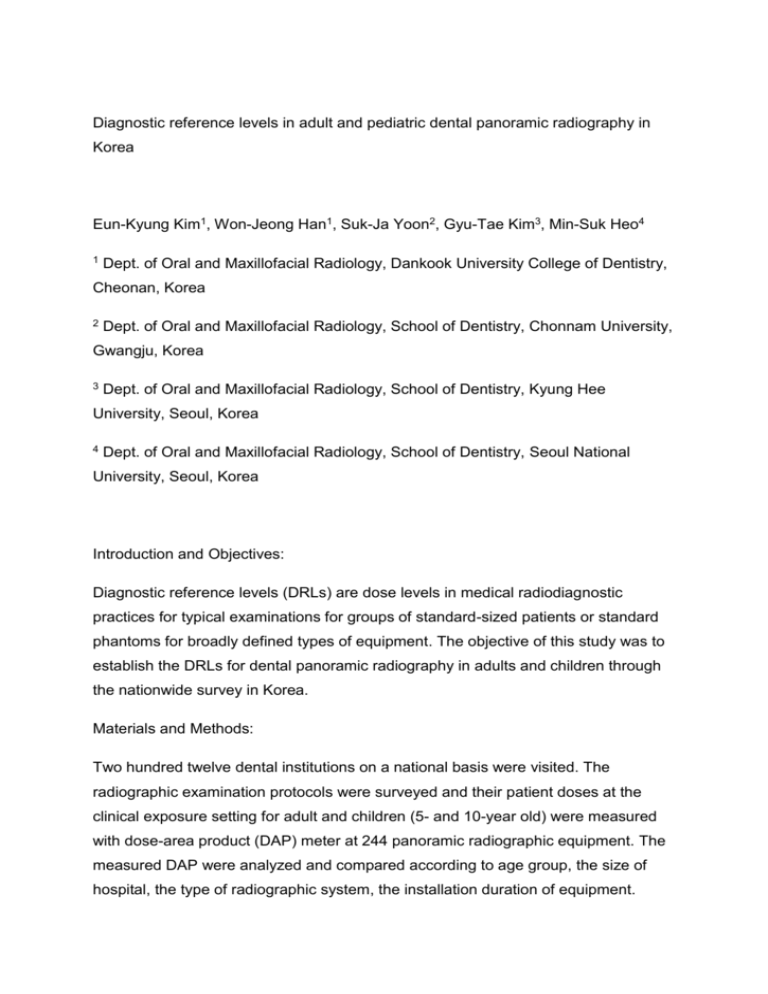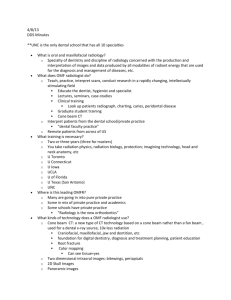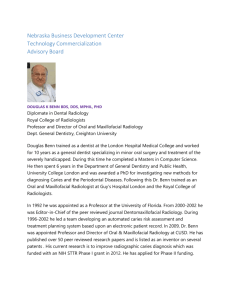Diagnostic reference levels in adult and pediatric dental panoramic
advertisement

Diagnostic reference levels in adult and pediatric dental panoramic radiography in Korea Eun-Kyung Kim1, Won-Jeong Han1, Suk-Ja Yoon2, Gyu-Tae Kim3, Min-Suk Heo4 1 Dept. of Oral and Maxillofacial Radiology, Dankook University College of Dentistry, Cheonan, Korea 2 Dept. of Oral and Maxillofacial Radiology, School of Dentistry, Chonnam University, Gwangju, Korea 3 Dept. of Oral and Maxillofacial Radiology, School of Dentistry, Kyung Hee University, Seoul, Korea 4 Dept. of Oral and Maxillofacial Radiology, School of Dentistry, Seoul National University, Seoul, Korea Introduction and Objectives: Diagnostic reference levels (DRLs) are dose levels in medical radiodiagnostic practices for typical examinations for groups of standard-sized patients or standard phantoms for broadly defined types of equipment. The objective of this study was to establish the DRLs for dental panoramic radiography in adults and children through the nationwide survey in Korea. Materials and Methods: Two hundred twelve dental institutions on a national basis were visited. The radiographic examination protocols were surveyed and their patient doses at the clinical exposure setting for adult and children (5- and 10-year old) were measured with dose-area product (DAP) meter at 244 panoramic radiographic equipment. The measured DAP were analyzed and compared according to age group, the size of hospital, the type of radiographic system, the installation duration of equipment. Results: The mean exposure parameters were 70.1 kV, 9.2 mA, 14.4 second for adult and 66.6 kV, 7.9mA, 13.8 second for 10-year old child and 65.5 kV, 7.3 mA, 13.7 second for 5-year old child. The mean and third quartile patient DAPs were 138.3 mGy cm2 and 151.0 mGy cm2 for adult , 99.5 mGy cm2 and 104.8 mGy cm2 for 10-year old child and 89.5 mGy cm2 and 95.5 mGy cm2 for 5-year old child. The mean patient dose at the university dental hospitals was lower than that at the dental clinic. The mean patient dose at the equipment of installation duration less than 5 year was higher than that at the equipment more than 10 year. The mean patient dose did not show statistically significant difference according to the type of radiographic system. Conclusions: DRLs for dental panoramic radiography in adult, 10- and 5-year old child were suggested to be 151 mGy cm2, 105 mGy cm2, and 97 mGy cm2 in Korea based on this nationwide survey.









